
Omega De Ville Quartz Ladies Watch, Black & Gold PVD
Ladies Omega De ville quartz black & gold PVD plated watch, marked Crown & back plate. Approx case width 18.5 mm, not running

Vintage Omega 9ct Yellow Gold Cocktail Watch, 17 Jewel Movement
Ladies Omega 9ct yellow gold cocktail watch marked 9c Omega, 17 jewel manual wind movement working when tested. Approx case width 17.5 mm, back plate weight 1.6 grams

Vintage Omega 9ct Rose Gold Ladies Watch, London Marked Case
Ladies vintage Omega 9ct rose gold watch marked case London 375 Owc Omega, Cal 562. Approx case wdith 19 mm, bacxk plate 1.5 grams

Omega Grand Prix 1900 Fob Watch for Restoration or Parts
Omega Grand Prix 1900 fob watch for restoration or parts. Approx case width 50 mm, not running a/f to dial
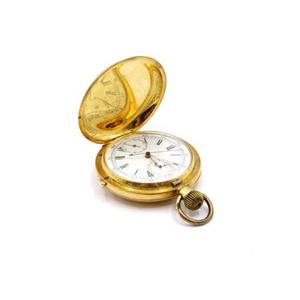
Rare 18ct Gold Swiss Flyback Chronograph Fob Watch, Omega Movement
18ct gold Swiss Flyback chronograph fob watch case marked Helvtia 18k to the case and back plate. The Omega movement is marked Omega, case width 52 mm, weight 114 grams. Flyback stem wind mechanism and functions working when tested. Engraved: presented to…

Omega Open Face Pocket Watch with Gold Plated Case
An Omega open face pocket watch, round silver tone dial with Arabic numerals and baton markers with subsidiary seconds dial on a 15 jewel, cal. 140 movement, ref. 1153 5, in gold plated case, with inscription 1952, size 44 mm, C - 1950, working, on gold…

Vintage Omega Trench Watch in Sterling Silver Case, Non-Running
Omega Trench watch likely in s sterling silver case. Does not run but crown turns, case width 35 mm

Omega 9ct Rose Gold Watch for Service
Ladies Omega 9ct rose gold watch for service marked 9c Omega. Has stopped. Approx case width 15.5 mm
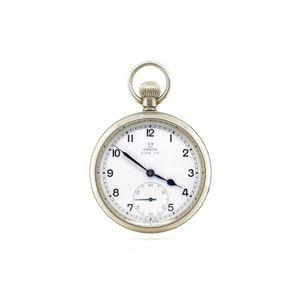
NSW Railways Omega Pocket Watch, 15 Jewel, Working
NSW Railways Omega pocket watch marked case back L 10455, dial: NSW Td, case width 51 mm, 15 jewel stem wind mechanism working when tested, serial #13382***
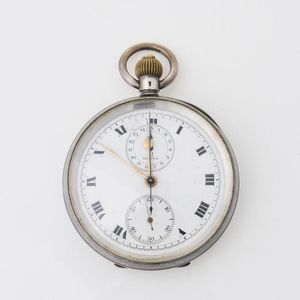
Vintage Omega Chronograph Pocket Watch in Sterling Silver Case
Vintage Omega pocket watch with sterling silver case. Chronograph movement with time function. White Roman dial with gold coloured main hands. Circa 1920's.In working order, however no time keeping test were carried out.

Omega Pocket Watch with Display Case and Knife
9ct rose gold pocket watch with original display case and pocket knife. Currently not in working condition. Original dial with sub second at 6 o'clock. Pocket knife with Omega branded logo on both sides.

1920's Omega Chronograph Pocket Watch with Sterling Silver Case
Vintage Omega pocket watch with sterling silver case. Chronograph movement with time function. White Roman dial. Circa 1920's

Omega Pocket Watch with Enamel Dial and Dent on Back
Omega pocket watch. Nickel cased, enamel dial with Arabic numerals marked Omega Nswtd. Face has hairlines and restoration. Back of case heavily dented, engraved L8248. Clean 15 jewel movement. Running.

Omega 9ct Hunter Cased Pocket Watch 1926
Omega 9ct hunter cased lever wind pocket watch, Roman numerals with seconds movement, machine engraved covers with inscription Patea 1926

Omega Chronograph Hunter Pocket Watch with Engraved Initials
Omega 18ct hunter cased lever wind chronograph pocket watch, Roman numerals with seconds and stopwatch subsidiary dials and sweeping seconds hand, front cover engraved with initials
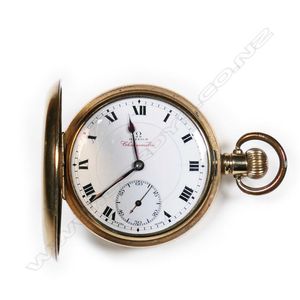
Omega Hunter Pocket Watch with 23 Jewel Movement
An Omega Chronometre gold plated hunter pocket watch, lever wind, 23 jewel movement, white enamel dial with Roman numerals and railtrack minutes, subsidiary seconds dial. Previous owner's name engraved inside cover. Dennison watch case, diameter 5.1 cm.

Antique Omega Niello Silver Pocket Watch, 1912
An antique Omega niello silver cased open face pocket watch, white dial, subsidiary seconds, Arabic numerals, outer minute track, blued hands, stem wind and set 15 jewel movement in a niello case depicting flowers with vacant cartouche, size 49 mm, minor…

Non-Running Vintage Omega De Ville Watch, 31mm Case
Vintage Omega de Ville watch movement marked Omega cal. 1339, 17 jewel battery, movement not running. #44 14,7002. Cased marked Omega 192 0047, case width 31 mm. Crown does not turn the minute hand
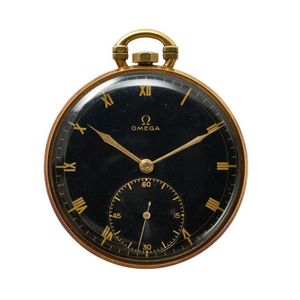
Omega 14ct Gold Pocket Watch, 1935
Omega, a 14ct gold openface pocket watch circa 1935, dial: black with Roman numerals, subsidiary seconds dial, calibre: cal. 37.5L manual winding, 17 jewels, movement number: 8765344, case: polished circular, snap on back, case number: 9434584, dimensions…
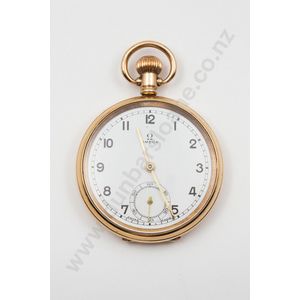
Omega Gold Plate Pocket Watch, Swiss 15J Movement
Omega gold plate open face lever wind pocket watch white enamel dial with Arabic numerals 15 jewels Swiss mechanism
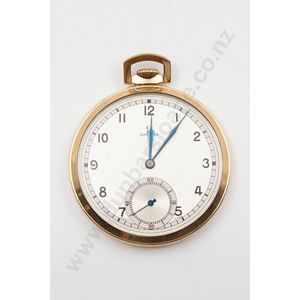
1920 Omega Gold Plated Pocket Watch, 15 Jewels
Circa 1920 Omega gold plated open face lever wind pocket watch plain silvered dial Arabic numerals with a Swiss made 15 jewel mechanism

Engraved Silver Hunter Pocket Watch with White Dial
Omega .925 silver hunter cased lever wind pocket watch white enamel dial with Arabic numerals, all machine engraved case

Vintage Ladies Omega Deville Watch, 1970s, Mechanical Movement
Ladies Omega Deville vintage watch with a mechanical 17 jewel movement. Cal. 485. Circa 1970s. Working when tested, case width 15.5 mm

Antique Omega Pocket Watch with Fairfax & Roberts Dial
An antique Omega open face pocket watch, white enamel dial signed Fairfax & Roberts Sydney & London, with Roman numerals, subsidiary seconds, stem wind and set 17 jewel movement and case marked Omega, case back engraved G.R 3991, possibly for Government…

Engraved Silver Hunter Pocket Watch with Roman Numerals
Omega .935 silver hunter cased lever wind pocket watch white enamel dial with Roman numerals and seconds movement, machine engraved covers

Omega Pocket Stopwatch with Box and Papers
Omega Stopwatch pocket watch timer stopwatch. Dial black. Calibre # 8160. With 7 jewel movement, with box and papers. Showing small minor signs of wear, in working order.

Omega Steam Train Pocket Watch
Omega 'Steam train' pocket watch decorated with a Steam train to the reverse. Stem wind mechanism working when tested. Width 52 mm. Provenance: The Logan estate.

Omega Pocket Watch with Rose Gold Hands and Arabic Numerals
Omega open face pocket watch, nickel dial with rose gold hands, Arabic numerals and subsidiary seconds dial, 7 cm high overall

1920 Omega 18ct Gold Openface Watch
Omega, an 18ct gold openface watch, circa 1920. Dial: white enamel, hairlined, Arabic numerals, subsidiary seconds dial, Breguet hands. Movement: Swiss lever movement. Movement number: 7668726. Case: 18ct gold plain polished with gold cuvette numbered…

1944 Omega Rose Gold Mechanical Watch with Salmon Dial
Omega 18ct rose gold mechanical watch marked 750 18k Omega to the case, Omega 17 jewel 106749**. With a salmon pinks dial. Circa 1944. Working when tested. Approx case width 36 mm

Limited Edition Omega Art Collection Watch, 1987
Omega Art collection a limited edition watch, by Omega, circa 1987 with reference number 51060527. Black dial, date function, May need service and battery 37 mm case diameter.

1954 Omega Watch for Restoration, 9ct Rose Gold
9ct rose gold Omega gentlemen's watch for restoration. Calibre 283, 17 jewel mechanical wind movement does not run. Circa 1954, marked to case, dial and movement, replacement crown. width 33 mm, back plate weight 5.2 grams

Omega Pocket Watch with Enamel Dial and Chain
An early 20th century Omega gent's pocket watch, the white metal open face with a white enamel dial. apparently working, with chain.

Omega Chronometer Deck Watch with Provenance
An Omega chronometer Deck watch, crown wind and set, circular cream dial with black Arabic numerals, subsidiary dial at six, gold plated case with chrome reverse, in fitted timber box with silver plaque with inscription, diameter 69 mm. Provenance:…
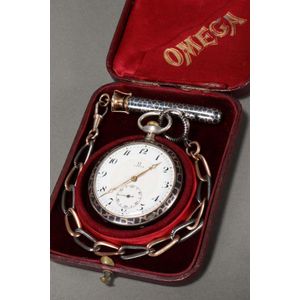
Omega Niello Pocket Watch Set with Chain and Pencil
Wonderful Omega silver niello pocket watch, chain and fob pencil, with white enamel dial, set with Arabic numerals and subsidiary dial, set within a niello scale pattern surface, with colour link chain and fob pencil, in original leather case

Omega Full Hunter Pocket Watch, 1934 Engraved, Boxed
A gents full hunter Omega pocket watch. 10ct gold filled, marked to dial and movement Omega, Dennison case #925944 engraved 1934, with plain polished case, detailed by initials engraved, white enamel dial, oversized black Arabic numerals in the Breguet…

Omega Open Faced Pocket Watch in 18ct Yellow Gold Plated
An open faced pocket watch by Omega, 18ct yellow gold plated case, marked to dial, case and movement Omega movement no 32688346, manual movement, silvered dial, baton markers, three hands, fitted with crown wind and bail.

1946 Omega Pocket Watch with 2-Tone Dial
A vintage Omega open face pocket watch, in stainless steel with 2 tone dial, subsidiary seconds, 15 jewel manual movement, case diam. 46 mm, C - 1946.

Sterling Silver Omega Pocket Watch with Fob Chain
A silver Omega pocket watch with fob chain and medallion, sterling silver, case by Dennison with English hallmarks, case no 88468, movement and dial marked Omega, movement no 5628245, with white enamel dial, black Roman numerals, sub dial, crown wind,…

Omega Pocket Watch, Guilloche Dial, 1912
An Omega open face pocket watch, part guilloche champagne dial, Arabic numerals, subsidiary seconds, 15 jewel stem wind and set movement, engine turned case diam. 48.6 mm, C - 1912.

Omega Military Pocket Watch, GSTP Y23139, 5cm Diameter
Omega military pocket watch in nickel plated case, back stamped 'G.S.T.P. (Y23139), 5 cm diameter
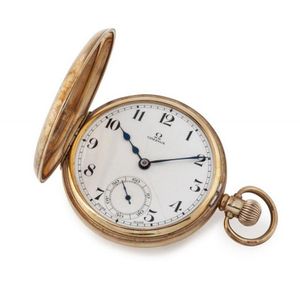
Omega Half Hunter Pocket Watch, 9ct Gold, Arabic & Roman Numerals
Omega 9ct gold cased half hunter pocket watch, Arabic numerals with subsidiary seconds dial and crown wind, Roman numerals on the external case, 5 cm diameter

Omega Pocket Watch with Gilded Bar Movement and Enamel Dial
A 20th century Omega pocket watch, in nickel hunter case, keyless gilded nickel bar movement, white enamel dial with subs-seconds, Arabic numerals, railtrack minutes, gold hands. Affixed Omega swing tag label.
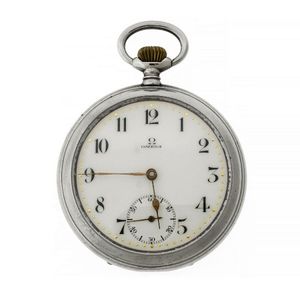
Omega Pocket Watch, 18J, Nickel Plated, Running, Enamel Dial
Omega pocket watch. 18 jewel movement in nickle plated case with good enamel dial. Running, unserviced

Working Omega Pocket Watch with Dennison Case
Omega gilt open faced pocket watch, (Omega movement and Dennison watch case), working when tested

Omega De Ville Quartz Watch with Date and 1337 Stamped
Omega De Ville quartz watch with date function, 1337 stamped on back of watch

1920s Omega Full Hunter Pocket Watch in Yellow Gold
9ct yellow gold Omega, full hunter pocket watch, c.1920s, top wind movement, white enamel dial with subsidiary second hand. Diameter 48 mm

Omega Full Hunter Pocket Watch, 1922
An Omega full hunter pocket watch, white enamel dial with Arabic numerals blued hands, subsidiary seconds on a stem wind and set plate movement in a rolled gold guilloche Starr case with monogrammed cartouche. Size 52.3 mm. C 1922.

1920s Omega Gold Hunter Pocket Watch, Subseconds Dial
Omega 18ct gold hunter cased pocket watch. C.1920s; subseconds dial. Running but unserviced. Portion of overlaid Crown missing; couple of minor dents to monogrammed case. Wt. 90g (total)
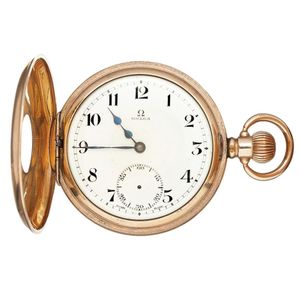
Swiss Omega Pocket Watch in English Dennison Half Hunter Case
An unusual Swiss Omega pocket watch in half hunter case, a marriage between the Swiss Omega N.5580262 movement fitted into an English Dennison gold plated half hunter style case. Inscription presentation dated 1923. Diameter 52 mm.

Swiss Omega Gold Plated Pocket Watch
A Swiss Omega gold plated open face pocket watch, signed and numbered N.3721417 in star rolled gold case. Enamel dial in good order. Diameter 51 mm.

1920s Omega Gold Pocket Watch, Enamel Dial, Paris Hallmark
A good Swiss Omega 14ct gold open face pocket watch, of stylish 1920's design with enamel dial and Arabic numerals in good order. Hallmarked 'Grand Prix' Paris 1900 case. Omega jewelled to centre lever movement with bi-metallic balance and micrometer…
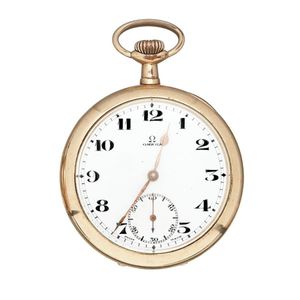
Elgin Case with Omega Swiss Pocket Watch, 1922
An Omega Swiss pocket watch in American Elgin case, the gold plated open face case marked Elgin USA and fitted with a Swiss Omega lever movement N.5916131, date 1922. Enamel dial in good order.

1925 A.L. Dennison Omega Pocketwatch in 9ct Gold, Birmingham
A 9ct gold A.L. Dennison / Omega pocketwatch, Birmingham, 1925. Weight: 91.1g (all in). Loose dial cover. Af

Omega 18K Gold Pocket Watch with Silk Fob (2)
Omega, 18 carat gold cased pocket watch. Case & movement signed with 9 carat & silk fob (2)

Vintage Omega Pocketwatch with Leather Pouch
A vintage Omega pocketwatch. A vintage base metal Omega pocket watch with inner second hand face. Comes in a leather pouch
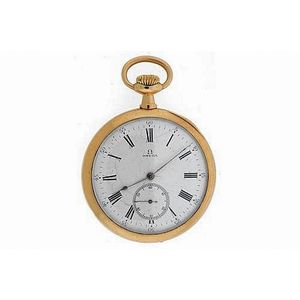
Omega 18ct Gold Pocket Watch - Not Working
Omega 18ct gold open face Gent's pocket watch; white dial with Roman numerals, outer minute indicators and subsidiary seconds. Diam. 50.4 mm. Wt. 77g. Not working.

Assorted Watches: Omega, Favre Leuba, Viceroy, and more
Seven assorted Watches; an Omega Seamaster Cosmic, a Favre Leuba with date, an early Viceroy and a Pierce (all working) an Omega Seamaster quartz with day date, a Raymond Weil quartz and a silver open face pocket watch (af).

Omega Hunter Pocket Watch, Lever Wind, Engraved Covers
9ct hunter cased pocket watch no 4061391 by Omega, plain dial with machine engraved covers, lever wind
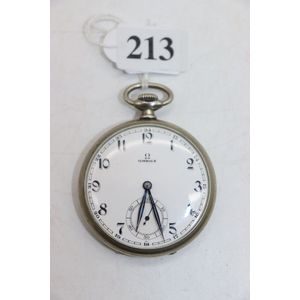




 Loading more...
Loading more...